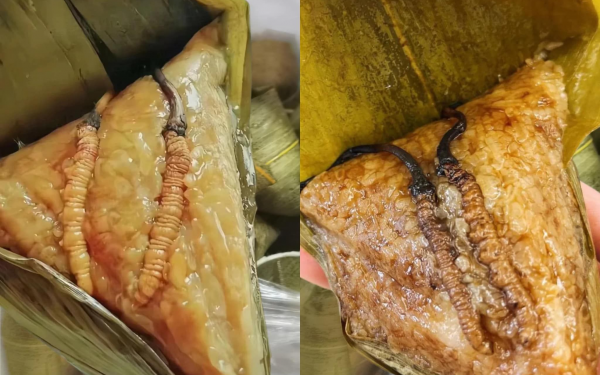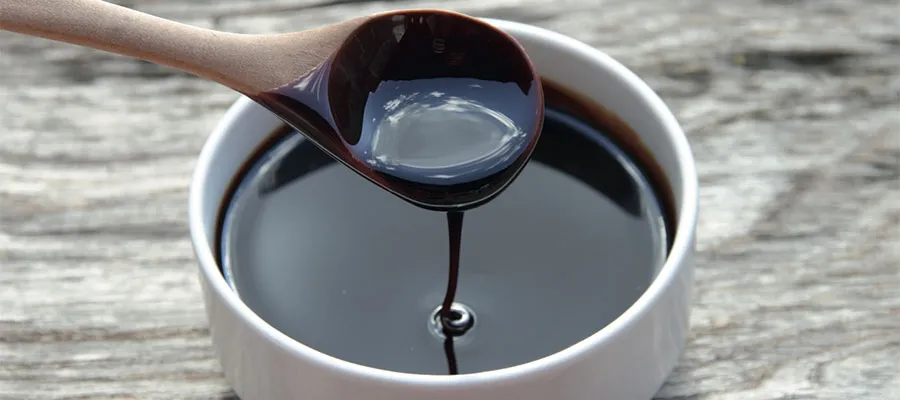Ash cake, known as banh tro, banh gio, or banh u tro, is a traditional Vietnamese delicacy with a rich cultural history. Simple yet captivating, this cake is made from glutinous rice soaked in alkaline water, then wrapped in natural leaves and boiled to perfection. Its unique translucent amber hue and soft, chewy texture make it a staple during festive seasons, particularly the Doan Ngo Festival. Let’s explore its origins, ingredients, preparation, and cultural significance.
The Origins of Ash Cake
Ash cake is believed to have originated in Guangdong, China, where it featured both sweet and savory fillings. When introduced to Vietnam, the recipe evolved to suit local tastes, resulting in a simplified version without filling. Instead, the Vietnamese banh tro is often paired with sweet molasses or sugar syrup, creating a delightful balance of flavors.

Beyond its culinary appeal, ash cake carries symbolic meaning during the Doan Ngo Festival. Celebrated on the 5th day of the 5th lunar month, this festival emphasizes purification and harmony, and the cake’s alkaline preparation aligns with these themes by aiding digestion and detoxification.
Ingredients for Traditional Ash Cake (25 Pieces)
To create 25 pieces of ash cake, you will need the following ingredients:
- 500g yellow glutinous rice: Provides the sticky and soft texture characteristic of ash cake.
- 500ml alkaline water (ash water): Made from plant ash such as rice straw, bamboo leaves, or bean husks.
- Dong leaves (or bamboo/banana leaves): Used for wrapping the cakes, adding a natural aroma.
- Molasses: A sweet dipping sauce to complement the cake’s light flavor.
- Salt: Enhances the overall taste.
- String for tying: Keeps the cakes securely wrapped during cooking.
Step-by-Step Guide to Making Ash Cake
Step 1: Soak the Rice
Start by thoroughly washing the glutinous rice to remove impurities. Then, soak it in a mixture of 1 liter of water and 500ml of ash water for about 22 hours. The alkaline water softens the rice and gives it its distinctive amber color.
To check if the rice is soaked enough, gently squeeze a grain; it should break easily. Once soaked, rinse the rice several times with clean water, drain it, and mix in a pinch of salt for added flavor.
Step 2: Prepare the Leaves
Wash the dong leaves thoroughly and dry them. Trim off the stems and thick veins to make them pliable and easy to wrap. The leaves not only hold the rice together but also infuse the cakes with a subtle earthy aroma during cooking.
Step 3: Wrap the Cake
Lay a dong leaf flat, and spread a thin layer of soaked rice (about 2 fingers thick) on top. Fold the edges of the leaf together, shaping it into a square or triangular form. Secure the wrapped cake tightly with string to prevent it from coming apart while boiling.
Pro tip: Since ash cakes are small, they may float during boiling, making it challenging to cook them evenly. Place a heavy object on top of the cakes in the pot to keep them submerged.
Step 4: Boil the Cakes
Submerge the wrapped cakes in a large pot of water, ensuring they are fully covered. Boil them for approximately 2–3 hours. Check the water level periodically and add hot water if needed to ensure even cooking.
Step 5: Make Molasses
If you can’t find molasses, you can easily make it at home. Heat a pan over medium heat, add white sugar, and let it melt into a golden amber liquid. Simmer until the mixture thickens into a syrupy consistency. Allow it to cool before serving.

The Finished Product: A Taste of Tradition
Once boiled, the ash cakes are ready to be unwrapped and enjoyed. The result is a translucent, amber-colored cake with a soft, chewy texture. The subtle flavor of the rice pairs perfectly with the sweet richness of molasses, creating a harmonious balance that is both light and satisfying.
Ash cake is more than just a dessert; it’s a symbol of simplicity and cultural heritage. Its cooling properties make it particularly refreshing, especially during summer festivals.
Cultural Significance of Banh Tro
Banh tro holds a special place in Vietnamese culture, especially during the Doan Ngo Festival. This festival, often referred to as the “Killing the Insects Festival,” focuses on health and cleansing. The alkaline nature of ash cake aligns with the festival’s theme by aiding digestion and detoxifying the body.
In addition to its health benefits, banh tro is a symbol of togetherness. Families often gather to prepare these cakes, strengthening bonds and passing down culinary traditions to younger generations.
A Simple Yet Sophisticated Tradition
While the process of making ash cake may seem humble, it requires patience and attention to detail. Each step, from soaking the rice to wrapping the leaves, reflects the care and artistry that goes into preserving traditional recipes. The cake’s unique texture, vibrant color, and symbolic significance make it a beloved part of Vietnamese cuisine.

Conclusion
Ash cake, or banh tro, is a culinary gem that beautifully combines simplicity, tradition, and health benefits. Its roots in ancient customs, combined with its light, refreshing flavor, make it a timeless favorite during festive celebrations. Whether dipped in molasses or enjoyed on its own, ash cake is a delicious reminder of the importance of preserving cultural heritage through food.
So next time you savor a piece of banh tro, take a moment to appreciate the artistry and history behind every bite.